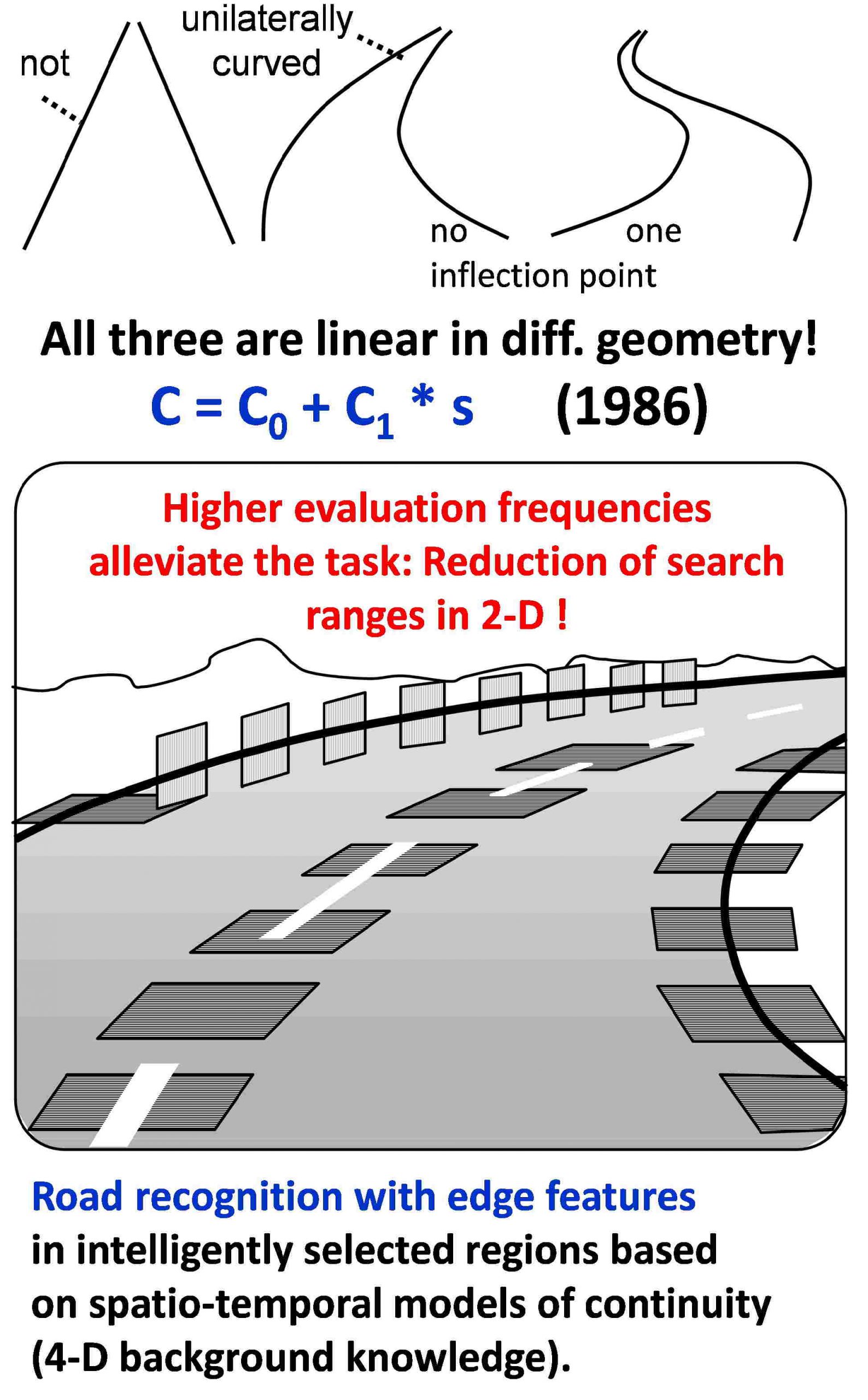The key to success, beside recursive estimation, was to describe road shape in differential-geometry terms:
- On the one side, this considerably reduces the number of parameters needed for describing a local road section; integration constants fixing global direction and position can be left off.
- On the other side, driving on a road at velocity V turns the differential-geometry description into an ordinary differential equation in time in a coordinate system moved with the vehicle.
- As early as 1987 this allowed driving at high speeds (up to Vmax = 96 km/h) on an obstacle-free stretch of Autobahn near Dingolfing with relatively little computing power available, when competitors using quasi-static approaches were at least an order of magnitude slower.
- The dynamic model of egomotion is very simple but represents the properties of Ackermann steering (standard in road vehicles) as control input quite well.
- The first demonstration of visual road vehicle guidance at speeds up to ~ 40 km/h was given to ‘Daimler-Benz AG Research’ in 1986.
Video – VaMoRsAutobahn Dingolfing 1987
(First high-speed road vehicle guidance by vision on a free stretch of Autobahn)
References
Dickmanns ED, Zapp A (1985). Guiding Land Vehicles Along Roadways by Computer Vision. Proc. Congres Automatique 1985, AFCET, Toulouse, pp 233-244
Dickmanns ED, Zapp A (1986). A Curvature-based Scheme for Improving Road Vehicle Guidance by Computer Vision. In: ‚Mobile Robots‘, SPIE Proc. Vol. 727, Cambridge, Mass., pp 161-168.
Mysliwetz B, Dickmanns ED (1986). A Vision System with Active Gaze Control for real-time Interpretation of Well Structured Dynamic Scenes. In L.O. Hertzberger (ed): Proc. of 1st Conference on Intelligent Autonomous Systems (IAS-1), Amsterdam, Dec. 1986, pp 477-483
Dickmanns ED, Zapp A (1987). Autonomous High Speed Road Vehicle Guidance by Computer Vision. 10th IFAC World Congress Munich, Prep rint Vol. 4, 1987, pp 232-237. pdf
Dickmanns ED, Graefe V (1988). a) Dynamic monocular machine vision. Machine Vision and Applications, Springer International, Vol. 1, pp 223-240. b) Applications of dynamic monocular machine vision. (ibid), pp 241-261. pdf_excerpts
Zapp A (1988). Automatische Straßenfahrzeugführung durch Rechnersehen, Dissertation UniBwM /LRT. Kurzfassung
Dickmanns ED, Mysliwetz B, Christians T (1990). Spatio-Temporal Guidance of Autonomous Vehicles by Computer Vision. IEEE-Transactions on Systems, Man and Cybernetics, Vol. 20, No. 6, Special Issue on Unmanned Vehicles and Intelligent Robotic Systems, pp 1273-1284
Mysliwetz B (1990). Parallelrechner-basierte Bildfolgen-Interpretation zur autonomen Fahrzeugsteuerung. Dissertation, UniBwM / LRT. Kurzfassung
Behringer R, von Holt V, Dickmanns D (1992). Road and Relative Ego-State Recognition. In: Proc. Int. Symp. ‚Intelligent Vehicles‘, IEEE, SAE, Detroit
Dickmanns ED, Mysliwetz B (1992). Recursive 3-D Road and Relative Ego-State Recognition. IEEE-Transactions PAMI, Vol. 14, No. 2, Special Issue on ‚Interpretation of 3-D Scenes‘, pp 199-213. Abstract (plus Introd.)
Behringer R (1994). Road Recognition from Multifocal Vision. In Masaki (ed.): Proc. of Int. Symp. on Intelligent Vehicles ’94, Paris, pp 302-307
Behringer R, Hötzl S (1994). Simultaneous Estimation of Pitch Angle and Lane Width from the Video Image of a Marked Road. IEEE-Conf. on Intelligent Robots and Systems (IROS’94), Neubiberg,
Brüdigam C (1994). Intelligente Fahrmanöver sehender autonomer Fahrzeuge in autobahnähnlicher Umgebung. Dissertation, UniBwM / LRT. Kurzfassung
Dickmanns ED (2007). Dynamic Vision for Perception and Control of Motion. Springer-Verlag, London. Contents
